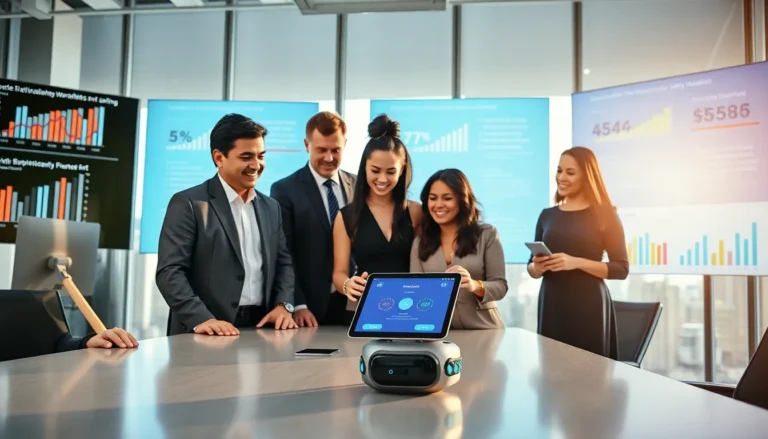Table of Contents
ToggleIn a world where your wrist can tell you about your heart rate, steps, and even your stress levels, the term “wearables” is becoming as familiar as your morning coffee. But what exactly is the wearables meaning? Are they just fancy gadgets or do they hold the key to revolutionizing how we interact with technology? This article dives deep into the fascinating realm of wearable technology, exploring its features, benefits, and even some hiccups along the way. Ready to discover how these handy devices might just change your life? Let’s jump in.
What Are Wearables?

Wearables refer to electronic devices worn close to or on the body, often tracking personal data related to health, fitness, and daily life. They encompass a myriad of devices, from simple step counters to sophisticated smartwatches that connect seamlessly to smartphones. Traditionally, wearables extended only to fitness trackers, but they’ve swiftly evolved into multifunctional tools. Wearables are designed not only to monitor health parameters like heartbeat or sleep quality but also to enhance communication, keep track of schedules, and even help smart home control. The convenience factors into daily routines, encouraging users to stay more active while providing immediate feedback on their physical state.
It’s interesting to see how their design increasingly prioritizes comfort and wearability, blending technology with fashion. Countless individuals now choose wearables that not only serve a functional purpose but also complement their style.
History of Wearable Technology
The history of wearable technology is as old as humanity’s desire to innovate. In the late 20th century, wearables began as rudimentary devices. The first noteworthy instance was in the late 1960s when computer scientist Edward Thorp designed a ‘wearable computer’ to aid in card counting while gambling. Fast forward to the 1980s, when devices like the calculator watch were introduced, creating a pop culture wave.
But, it wasn’t until the 2000s that wearable technology gained significant traction. The launch of devices like the Fitbit revolutionized how people monitored their health and fitness. The surge in smartphone popularity accelerated this trend, allowing wearables to integrate apps and connect to mobile devices. With innovations like smart glasses and hearable technology now entering the market, we find ourselves standing at the intersection of fashion, functionality, and high-tech.
Types of Wearable Devices
Wearable technology comes in various types, each catering to specific needs and interests. Below are some common categories of wearables:
Fitness Trackers
These devices focus on physical activity, monitoring steps taken, calories burned, and sleep patterns. Brands like Fitbit and Garmin dominate this space, helping users set and achieve their fitness goals.
Smartwatches
Smartwatches, such as the Apple Watch and Samsung Galaxy Watch, offer more than fitness tracking. They provide notifications, apps, and sometimes cellular connectivity, effectively merging traditional watch functions with smartphone technology.
Smart Clothing
Innovative garments equipped with sensory technology are becoming increasingly popular. These can monitor body temperature, heart rate, and muscle exertion.
Hearables
This emerging category includes smart earbuds and headphones that track fitness and provide seamless access to voice assistants. They can enhance the audiophiles’ experience while keeping users connected.
Medical Wearables
Devices like glucose monitors and ECG monitors are crucial for real-time health monitoring, facilitating instant feedback and aiding in better health management.
How Wearables Work
Wearables depend on a mix of hardware and software components that work together to track various data points. Most devices are equipped with sensors to monitor specific parameters. For instance, accelerometers measure movement, while heart rate sensors monitor cardiac activity.
Data collected by these sensors is sent to a central processing unit, often in the form of a mobile app. This app analyzes the data and provides users with actionable insights. Here’s a peek into how it typically works:
- Data Collection: Sensors gather data, whether it’s steps taken, calories burned, or heart rate.
- Data Transmission: The wearable sends this information to an app on a paired smartphone, usually via Bluetooth.
- Data Analysis: The app processes and analyzes the information, serving meaningful feedback or alerts.
- User Interaction: Finally, users can view their data, set goals, and receive suggestions, all tailored to enhance their experience.
The seamless integration of hardware and software is what makes wearables so appealing.
Benefits of Wearable Technology
Wearable technology boasts a treasure trove of benefits that extend beyond mere data collection. Here are some of the remarkable advantages:
Health Monitoring
Wearables empower users to track their health metrics continuously, allowing individuals to make informed lifestyle changes. Regular monitoring encourages proactive health management, significantly reducing hospital visits.
Motivation and Engagement
Fitness trackers and smartwatches provide motivation through gamified features, encouraging users to achieve daily activity goals. The ability to set reminders or alarms to move promotes a more active lifestyle.
Seamless Connectivity
Wearables can keep users connected while minimizing distractions. Instead of digging through a bag for a smartphone, a glance at the wrist informs users of essential notifications directly, enhancing productivity.
Data-Driven Insights
Collecting data empowers users, enabling them to understand their habits. Tailored insights help in decision-making processes, whether that’s optimizing workouts or improving sleep quality.
Convenience
With features like heart rate monitoring, GPS tracking, and contactless payments, wearables add a layer of convenience to daily activities, making life a bit smoother.
Challenges and Limitations of Wearables
Even though their many benefits, wearable technology faces some challenges and limitations. A few key points to consider include:
Battery Life
Many wearables suffer from limited battery life, necessitating frequent charging. Users often find themselves tethered to chargers, especially with multifunctional devices.
Data Privacy
As wearables collect sensitive health data, privacy becomes a growing concern. Users must be cautious about how and where their data is shared, often questioning the security of their personal information.
Functionality vs. Usability
Some wearables sacrifice functionality for style or vice versa. Often, users may find that while a device looks nice, it doesn’t meet their practical needs effectively.
Accuracy
Not all wearables offer perfectly accurate readings. Variability in sensor technology can lead to discrepancies, and users sometimes must learn to discern which data is meaningful.
The Future of Wearable Technology
The future of wearable technology seems bright, with innovations continuing to emerge. Companies are focusing on enhancing user experiences through AI and machine learning integration. Not only are smarter sensors being developed, but designs are becoming increasingly health-oriented, with intuitive interfaces and personalized features.
Wearable technology is expected to expand into new areas, such as smart health devices that can detect early signs of medical issues, improving overall patient outcomes. Increased collaboration between tech and healthcare industries suggests a trend toward more holistic monitoring.
The incorporation of augmented reality (AR) into wearables is also anticipated, revolutionizing how users interact with their devices and environments. As the technology continues to advance, wearables may soon be indispensable tools for better living.




